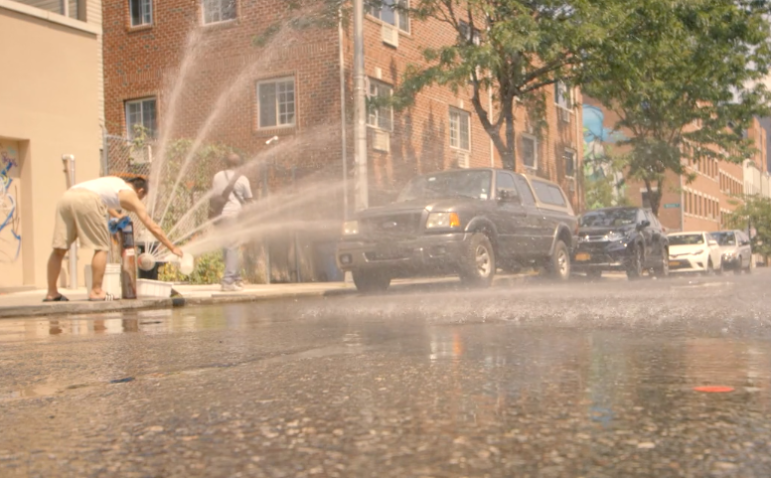
BRIC-TV
Bushwick in July. Away from the hydrant’s spray, it was very, very hot.
There were some hot summers for New York City between 1971 and 2000—Julys when people dragged mattresses out onto their fire escapes and Augusts when sun-drenched streets felt like frying pans and subway stations like ovens. Averaging those 30 years, scientists say the baseline for days with highs of 90 degrees or higher was 10 days in a typical summer.
By the 2080s, the city could see 24 to 75 days with highs above 90 degrees. As soon as the 2050s, the city will see not the current two but an average of six heat waves each year. As with the likelihood more frequent or intense coastal storms on New York’s lengthy waterfront, heat is a climate-change impact that will have a bigger impact in the Big Apple than in other places.
“One of the phenomenons that we deal with with extreme heat is the urban heat island effect, which means that cities tend to be hotter than rural areas or surrounding areas — up to 22 degrees hotter, actually,” Jainey Bavishi, director of the Mayor’s Office of Recovery and Resiliency and the city’s deputy chief resilience officer, told BRIC-TV and City Limits. “And it’s because of our density, the dark impervious surfaces that we have all over the city, like roads and black tar roofs and limited vegetation. And so cities tend to be hotter.”
The likely human impact of the increase in extreme heat is simple: It means is that more people will likely die, maybe a lot more.
According to the Department of Health and Mental Hygiene, right now an average of about 130 New Yorkers perish from heat-related causes every year—13 on average die directly from heat stroke, and 115 from other causes exacerbated by heat.
Under some projections, the number of deaths linked to extreme heat in New York City could quadruple by the end of this century, although much depends on the climate-change model used, patterns of population growth that play out, and what kind of adaptive measures people use.
Death, however, isn’t the only impact. Heat sickens many whom it doesn’t kill, affecting work and school performance. Even the materials that make up the physical city can be affected; according to recent city design guidelines, “Thermal expansion, warping, softening, or other forms of material change or degradation of structural integrity [occur] at an accelerated rate” during excessive heat.
Bushwick Heat
Watch the BRIC-City Limits Special Report
ABCs of ACs
Then there’s the impact of the steps New Yorkers take to deal with heavy heat.
Window-unit air-conditioners can provide crucial relief inside apartments, which is where heat deaths in New York City tend to occur. In a study of New York City heat-stroke deaths from 2008 through 2011 reported by the Centers for Disease Control, 85 percent of those felled by heat died in their own homes, and in cases where there was data on air-conditioning, 88 percent of deaths occurred in homes that did not have an air conditioner.
“A lot of people, you know, lower-income people, don’t actually have AC in their homes,” says Leslie Velasquez, Environmental Justice Program Manager at El Puente, a long-standing community organization in Williamsburg.”The AC unit itself can be prohibitively expensive,” she says. And if you live in an apartment where the window is barred, “you’d have to ask the landlord or the city to remove them and then you have to buy the unit yourself and then, actually, the power for the unit is very expensive, too, in terms of electric costs.”
About 86 percent of New Yorkers do have air conditioning, but that’s not a panacea. Walk down a street in a neighborhood like Bushwick during the summer and you will see window-unit air-conditioners – maybe one small machine for each apartment, cooling one room in a home that might house more than one family.
“And they might not be even good enough to cool a room. Or maybe in most cases they’re probably able to cool a small bedroom. But you know people are not sleeping in their bed all day long,” notes Prathap Ramamurthy, a professor of mechanical engineering at City College who has done extensive research on urban heat islands.
Plus, window units merely displace heat into the street, adding to the oppressive conditions for people moving about. And the electricity demand driven by air conditioning creates its own problems.
“During extreme heat weather events there’s an intense increase in energy consumption,” says Annel Hernandez, associate director of the New York City Environmental Justice Alliance. “And when that happens the [utilities] turn on their peaker plants, which often tend to be the most polluting plants in the city and they are all located in environmental justice communities. So it’s just exacerbating the issue of air quality, which is worsened by extreme heat and it just has a compounding effect.”
According to some research, the state’s “peaking plants” can produce a third of the state’s nitrogen oxide emissions when they’re turned on. Governor Cuomo earlier this year issued regulations to reduce pollution from those plants.
Specifying the risks
Understanding of the heat risk to New York City is evolving. The New York City Panel on Climate Change earlier this year issued a report that, unlike its earlier research, looked not just at the number of hot days and heat waves that are expected but also at the severity of the heat that will hit during those episodes: The average temperature during heat waves is expected to increase from 93 degrees to 95 to 98 degrees by the 2080s. And the panel looked for first time at humidity as an additional risk factor.
Meanwhile, official data gathering and citizen science continues to sharpen the understanding of neighborhood-specific heat risks. While all of the city will deal with more heat in the future, some communities will feel harsher extremes.
“New York is a pretty big city. It has very varying landscapes and there is a lot of intra-urban variability,” says Ramamurthy. “The first thing is how tightly and closely the buildings are packed. If there is more space between the buildings, then you could expect the neighborhood to be a little bit less hot. Also, the amount of green space like trees can really dictate if you have a lot of shadows covering the streets. Then you can expect to have a cooler place.”
The science of localized heat effects is complex. It’s clear that neighborhoods without a sea breeze, or with less green space, will suffer more from heat: Temperatures at the city’s JFK Airport weather station tend to be 2.1 degrees cooler in the summer, on average, than the station at Central Park because of the breeze off Jamaica Bay.
But other aspects of heat are harder to calculate. Streets with tall buildings, for instance, are shielded from the sun’s rays during the day, but those same buildings can trap heat from escaping during the night. And even when the streets do cool down, it doesn’t mean that conditions inside buildings are improving.
“During the daytime, you get a lot of the sunlight and then our buildings absorb this radiation and keep this in. So in the nighttime even when the outside cools down, inside the buildings they don’t really cool down,” Ramamurthy says. “People experience heatwave-like conditions indoors even two to three days after the heatwave ends.” Indeed, one problem with how heat risks are understood is that some studies only count deaths that occur during heat waves as heat-related, when heat can be dangerous at other times, too.
Velasquez says the heat is tangibly more intense in some of the neighborhoods where she works, like Williamsburg and Bushwick. “You can feel it. There’s not a lot of shade, there’s just concrete—sort of everywhere. And so it all is just like bouncing at you,” she says. “Yeah, it’s impossible to escape.”
The de Blasio administration has mapped which neighborhoods face the highest heat risks. It’s not just physical factors that matter. “Incidence of poverty, or lack of social cohesion are things that can make [a neighborhood] more vulnerable to extreme heat,” she says. And older New Yorkers and those with chronic illnesses face particular risks.
Dealing with it
The city’s response to the heat threat began in 2009, with the launch of the Cool Roofs program, which paints reflective coating atop buildings to reduce heat absorption. More than 10 million square feet of rood have been painted so far. The de Blasio administration has worked to concentrate those painting projects in the most heat-vulnerable neighborhoods.
“When you do it in clusters in a particular neighborhood it can also have a cooling effect across some neighborhoods and bring down the ambient temperatures,” Bavishi says. “Our goal is to continue to coat at least a million square feet every year for the next several years.”
More recently, the city has launched the Cool Neighborhoods program, which targets the planting of street trees in vulnerable neighborhoods. The city has also converted a modest amount of street surface to lighter color.
Those steps are about reducing heat. When it comes to dealing with heat when it comes, the city focuses on communication: telling home-care providers to be alert to be alert to the risks seniors face when it is hot, encouraging New Yorkers to “be a buddy” and check on vulnerable neighbors, and trying to get health and weather reporters to provide accurate warnings about heat risks and smart tips for reducing dangers.
The city’s highest profile response to heat is the opening of dozens of cooling centers around the city offering free AC to New Yorkers who don’t have it at home. While they agree that cooling centers are a good resource, some advocates believe the city needs to improve that way it runs the heat-response system. “They don’t have a very robust process to manage these cooling centers,” says Hernandez. Her organization has surveyed centers in the past and found, “Some places don’t know that they’re a cooling center. Some places are not open. Some places don’t have AC working or don’t have water available.” And the fact that the city doesn’t publish the list of cooling centers until a weather emergency exists makes planning difficult, she says.
A spokesman for the de Blasio administration tells City Limits: “The cooling center structure allows the city to leverage trusted programs that are known and valued by the communities they serve. The city conducts extensive evaluations of cooling center partner facilities to ensure locations are operational prior to the summer and in advance of heat emergencies. The city conducts continuous analysis with our cooling center partners to seek improvements to the system, and remains dedicated to providing cool spaces for all New Yorkers during periods of extreme heat.”
More broadly, experts and advocates believe the city needs to make a significantly larger commitment to creating and preserving green space if it hopes to beat the heat. “I think the city is not adequately giving the value to street trees and all of the benefits that it provides,” Hernandez says. “A street tree is providing urban heat island mitigation, it’s providing air-quality benefits, it’s creating new spaces in the community, and they’re not valuing all of those things. They’re just looking at the cost of what it takes to build that.”
Given the scope of the problem and the size of the city, however, there are big unknowns. “Urban greening has been touted as a big strategy. But we really don’t know what scale it needs to be implemented in,” says Ramamurthy. “If you have to cool the city there’s a big scaling problem. Like, how much greenery do we need to plant?”


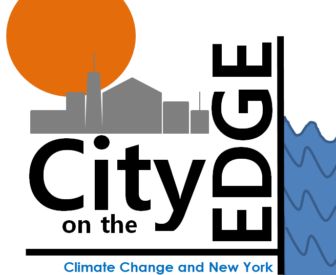
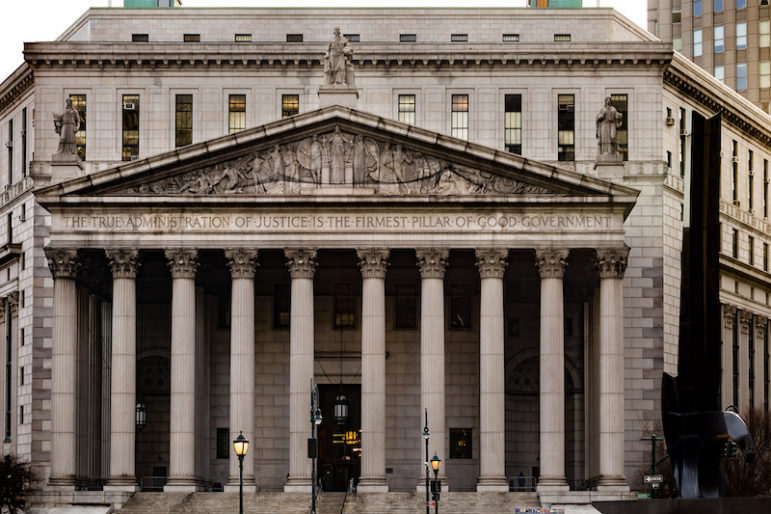

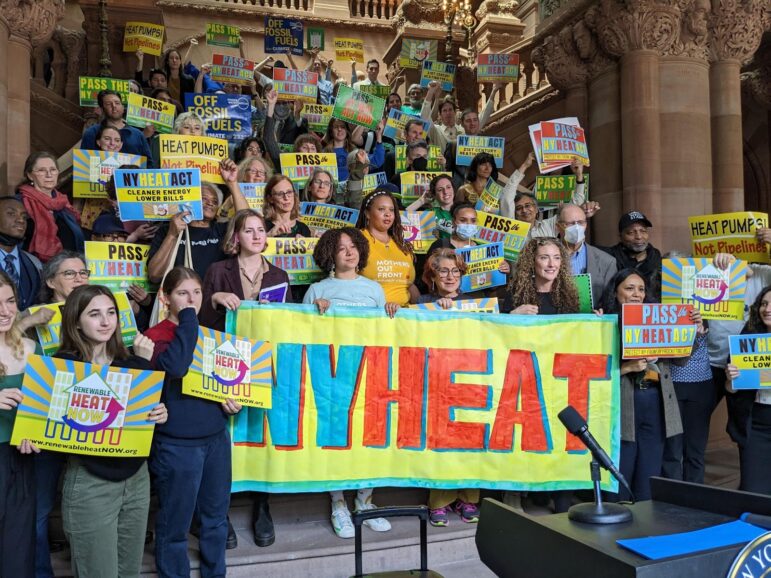

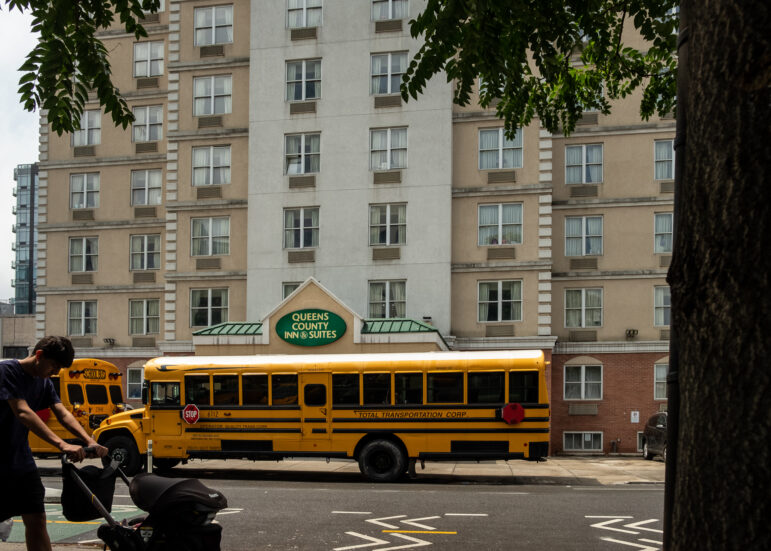


0 thoughts on “The Summer of 2019 is Over but the Heat Risk to NYC is Not Going Away”
Just finished re-doing my Cool Roof. Second coat tomorrow. I’ll be ready.
By my estimate(and the NYT weather reports) Summer 2019 was 11% warmer than average but Winter 2018-2019 was 6% warmer than average. Since it requires less energy to cool air than to heat air I believe we are still ahead of the game. Remember, by 2050 NYC will have the climate of North Carolina. People retire from NYC to NC so I think we have something good to look forward to as we go. There should be a cost savings to NYC people with our heating bills coming down, offset by AC bills of course, and if someone could capture the future savings we could finance a piece of the Green Revolution!